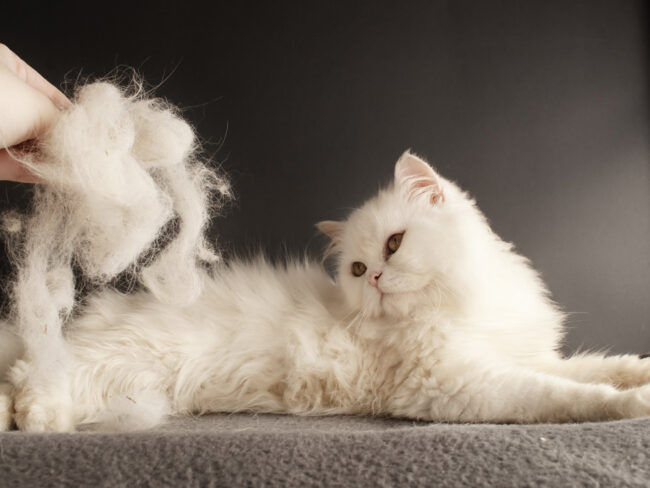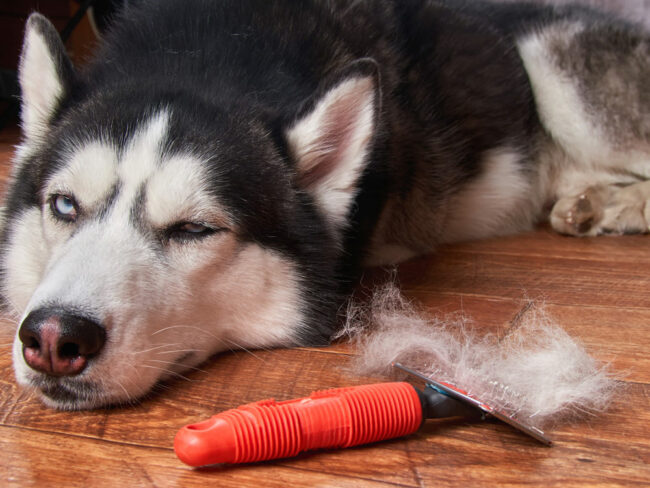You wake up in the morning, you yawn, and you stretch when you try to get out of bed. Before you finish yawning, you realise there is a cat (or dog) hair in your mouth.
You then go into the bathroom for your morning shower. You take a towel to wipe your face, and you find a few fine strands of hair clinging onto the towel and about to transfer to your face. You take a look around your environment, there’s hair everywhere, the sofa, the jacket, the electronics, and sometimes, inside the food. Though it is said that food taste better with cat (or dog) hair, it is an acquired taste and many of us prefer to have our food without.
In the natural world, animals shed their hair in response to the daylight availability, and the change of season will affect whether an animal has a thicker or thinner coat. Naturally, shedding is most prominent in spring and autumn. Not the case for our pampered indoor furry kids. Year-round artificial lighting plus air-conditioning inside our home means a lighter volume, but year-round shedding, creating an almost constant source of mess and a source of itchy nose and not so perfect black clothes.
Another myth is that short haired pets shed less. It is actually not the case. Long and short haired pets both go through the same four phases of hair growth cycle, but since the “catagen phase”, the phase when the new hair reach their maximum length is shorter for short haired pets, the whole cycle is completed faster than long haired pets, thus making them shed more in quantity, but less visible compared with their longhaired counterparts.
There is nothing much we can do to stop them from shedding. In fact, a healthy turnover of hair coat is a sign of good metabolism. It is the aftermath that we need to take care of. For example, long haired pets tend to get matted knots in the under coat, and that in turn trap excessive moisture and create a microenvironment that promotes bacteria or fungus growth, causing our pets to itch and eventually skin problems. Cats that groom themselves (or another animal) excessively get hairball in their stomach. In milder cases, affected cats will retch the fur ball out, and in more serious cases, the hairball can act as a foreign object and obstruct the digestive tract.


The medical name for such hairball is trichobezoar, it sounds as weird as it is uncomfortable for your cats.
So what is the solution? Shaving them bald is not always the answer. A lot of cats hate to be shaved and suffer from low self-esteem (or just crankiness) after the haircut. Pets with a single coat, e.g. Poodles and Shih Tzus, can be shaved, but care must be taken to avoid cutting the skin. Pets with a double coat should be brushed rather than shaved. Once the undercoat is removed, air can circulate underneath the outer coat, creating a cooler environment for the skin. Also, the outer coat actually acts as a natural insect repellent and sun-screen. Double coated pets, if brushed properly, benefit more from keep the hair rather than losing it. Lastly, some breed, e.g. Pomeranian, have delicate skin coat, and hair may not grow back, or grow back in patches after shaving.
What is the best thing to do to combat shedding? Pets should be brushed daily with a suitable brush and bathe regularly with an appropriate shampoo and conditioner. The purpose of the conditioner is not just to look pretty, but help loose hair falls off the body easily. Cats with hairball issues can benefit from “hairball control” diet or oral hairball paste once to twice a week. Last but not least, invest in a good vacuum cleaner and HEPA air-filter for the benefit of the humans!
